Do you have a question about the Sea Ray 390 Sundancer and is the answer not in the manual?
Details the contents of the owner's manual packet for the boat, including manuals and information.
Explains the section providing information from equipment manufacturers installed on the boat.
Outlines the information provided in the manual and the required operator knowledge for safe boat operation.
Details the owner's obligations for ensuring safety, including taking courses and following rules.
Describes the dealer's duties in providing boat information, demonstrations, and warranty reviews.
Explains the importance of the HIN for all correspondence and orders related to the boat.
Details Sea Ray's adherence to safety acts and industry standards like ABYC and NMMA.
Advises taking the boat to an authorized dealer for service and parts, with contact information provided.
Lists contact phone numbers and internet addresses for Sea Ray, USCG, and BoatUS Foundation.
Details what the limited warranty covers, excludes, and disclaims implied warranties.
Explains the process and conditions for transferring the unexpired warranty term to a new owner.
Lists key principles for safe boating and emphasizes acquiring skills through courses and training.
Explains the meaning of different safety label types (Danger, Warning, Caution, Notice) and their importance.
Details legally mandated equipment like PFDs and fire extinguishers, with specific requirements for vessel length.
Explains how the automatic fire extinguisher system works and the immediate actions required when it actuates.
Describes the symptoms of CO poisoning and dangerous conditions for CO accumulation.
Provides guidelines on maintaining ventilation and avoiding CO buildup when engines or generators are running.
Explains the purpose of PFDs and the legal requirements for carrying them on board.
Details the function of CO monitors and the importance of understanding their operation.
Describes different types of PFDs (Type I, II, III, V) and their intended uses and buoyancy.
Lists recommended additional gear for safe operation, including first aid kits, charts, and communication devices.
Warns against operating the boat under the influence of drugs or alcohol due to severe safety risks.
Explains how to determine and adhere to the boat's load capacity for safety, referencing certification plates.
Discusses how load distribution, added equipment, and hull contents can affect stability and cause capsizing.
Emphasizes constant operator awareness of surroundings and hazards for safe boat handling.
Advises knowing boat handling limits, instructing passengers, and maintaining awareness of conditions.
Explains boat design categories (A, B, C, D) and operating limitations based on wind and sea conditions.
Provides safety advice for severe weather, lightning, and fog, emphasizing seeking safe harbor and proper procedures.
Stresses the need for using NOAA charts, understanding navigational aids, and being aware of hazards to avoid unsafe areas.
Details safety measures for swimming around boats, including engine shut-off procedures.
Provides advice on water skiing safety, including proper boat operation and hand signals for communication.
Explains the meaning of diving flags and the required distance to maintain from diving operations.
Outlines the legal obligation to assist distressed boaters and the steps for performing a water rescue safely.
Provides guidance on fighting boat fires, including using extinguishers and abandoning the boat if necessary.
Details actions to take in case of flooding, swamping, or capsizing, emphasizing staying with the boat.
Advises on actions to take after a collision, including reporting requirements and leak management.
Outlines steps to take if the boat runs aground or experiences propulsion, control, or steering failure.
Provides contact information for safety hotlines and lists international regulatory authorities for vessel construction.
Defines various nautical terms used in the manual and for boat operation, covering parts of the boat and actions.
Details regulations and best practices for preventing fuel and oil spills, including bilge discharge and tank filling.
Covers regulations for waste disposal, noise limits, and managing boat wakes in waterways.
Provides a key to understanding various symbols used on controls, gauges, and in the manual for identifying functions.
Explains regulations on discharging plastic, garbage, and other waste into various water bodies, with penalties for violations.
Illustrates the placement of various warning labels throughout the boat, highlighting potential hazards.
Details specific warnings related to oil discharge, fuel leaks, towing, and unattended dockside water connections.
Highlights critical warnings regarding carbon monoxide hazards and collision avoidance measures at the helm.
Provides guidance on proper docking, lifting, and storage methods to prevent hull stress and damage.
Clarifies that cleats are for docking/mooring, not for lifting the boat, and illustrates correct lifting points.
Explains the importance of correct cradle support to avoid hull stress and illustrates correct vs. incorrect support methods.
Advises passengers to be seated and hold on during boat movement and to be prepared for sudden maneuvers.
Illustrates passenger locations and warns against standing or walking in hazardous areas during operation.
Provides detailed dimensions and clearance information for the boat, including length, beam, draft, and heights.
Describes the V-drive engine system and offers advice on propeller selection and maintenance for optimal performance.
Illustrates the general deck layout, labeling various components like anchor chute, cleats, and hatches.
Provides a detailed layout of the cabin interior, identifying staterooms, salon, galley, and head areas.
Labels various equipment mounted on the boat's spoiler, such as speakers and antennas.
Details the layout and identification of gauges, switches, and controls at the helm station.
Illustrates the gauge panel layout, including engine multiguages, tachometers, and the SmartCraft system view.
Shows the gauge panel layout featuring the optional Sea Ray Navigator system for navigation and information display.
Displays the switch panel layout for gas engine configurations, detailing various system controls.
Displays the switch panel layout for diesel engine configurations, detailing various system controls.
Identifies and illustrates the location of through-hull fittings on the starboard side of the boat.
Identifies and illustrates the location of through-hull fittings on the port side of the boat.
Illustrates the location of through-hull fittings and cutouts within the bilge area.
Identifies through-hull fittings and cutouts located on the transom of the boat.
Explains the operation of the dual hydraulic gear shift and throttle controls, including safety precautions.
Details the function, maintenance, and operation of throttle levers and gearshift levers.
Explains the function of optional engine synchronizers and the operation of hydraulic trim tabs.
Describes the trim tab system components and how to operate them for boat attitude adjustment.
Illustrates how trim tab adjustments affect the boat's trim and list, providing visual examples.
Explains the tachometer's role in displaying engine RPM and the importance of staying within operating limits.
Details the functions of the 4-in-1 multigauge (oil pressure, temp, voltage, fuel) and the fuel gauge accuracy.
Explains how to interpret voltmeter and oil pressure gauge readings, including troubleshooting steps.
Details the water temperature gauge function and the optional engine synchronizer gauge for RPM matching.
Explains the function of hourmeters for tracking engine and generator operating time for maintenance.
Describes the fire system indicator light and its function for diesel-powered boats.
Provides guidance on using and adjusting a magnetic compass for accurate navigation.
Explains the components and function of the Systems Monitor for displaying system status and alarms.
Details how audible alarms alert the operator and the function of the Audible Reset/Alarm Select button.
Explains how the Alarm Select feature manages and scrolls through multiple active alarms.
Provides instructions on how to monitor critical engine and generator functions using the Systems Monitor.
Lists functions, descriptions, and DCM displays for various system status and alarm conditions.
Explains the SmartCraft System as a boat information center for monitoring operational data.
Details the features of the optional Sea Ray Navigator, an onboard computer navigation aid.
Instructs on operating navigation lights for underway and anchor lights for moored situations.
Explains the function of the console dimmer control for adjusting the intensity of gauge and switch panel lights.
Identifies switches and receptacles located in the salon and galley areas of the boat.
Details the location of switches and receptacles within the aft and master staterooms.
Illustrates the location of switches and receptacles in the cockpit and at the control station.
Shows the layout of interior and exterior lighting fixtures, including bulb types for replacement.
Illustrates the placement of various interior lighting fixtures and provides bulb replacement information.
Lists essential pre-departure checks including weather, passengers, tools, and navigation charts.
Outlines checks for boat systems like bilge, shore power, trim tabs, and fresh water before departure.
Details crucial pre-departure checks for engines, including fuel, oil, batteries, and controls.
Provides guidance on safe operation while underway, covering passengers, navigation, and weather monitoring.
Outlines steps for safely returning to port, including passenger roles and engine shutdown.
Details procedures for securing the boat, including shore power, fenders, and closing systems.
Covers essential safety precautions during fueling, including daylight operation and tank filling procedures.
Advises on safe boarding procedures, including avoiding overloading and handling gear.
Emphasizes the importance of PFDs, their proper use, accessibility, and mandatory wear for certain individuals.
Details how to instruct passengers on boat behavior and safety during operation.
Outlines pre-start checks, including battery solenoids, fuel levels, and oil/coolant levels.
Describes the engine starting sequence, including ignition, gear shift positions, and monitoring RPM to avoid exceeding limits.
Explains the operation of the dual hydraulic gear shift and throttle controls, including safety warnings for reversing at speed.
Details the steps for safely stopping the boat's engines, including returning controls to idle and neutral.
Provides instructions for starting and operating the generator, emphasizing compliance with manufacturer guidelines.
Outlines pre-start checks for the generator, including fuel levels, coolant, seacock, and bilge blowers.
Provides specific instructions for starting the generator on diesel-equipped models.
Details the sequence for starting the generator, including preheat and start/run switches, and cooling down.
Explains how to stop the generator and manage AC breakers for a safe transition.
Provides detailed steps for safely connecting to shore power, including breaker operations and voltage checks.
Outlines the procedure for safely disconnecting shore power, emphasizing cord care and storage.
Explains how to switch from shore power to generator power, including breaker and system settings.
Details the steps for disconnecting the shore power cord from the boat's receptacle and its maintenance.
Provides guidance on maintaining shore power cables and inlets, including cleaning and moisture protection.
Explains the operation and maintenance of the hydraulic steering system, including fluid checks and connection inspections.
Describes the basic anchoring process, including bow into wind/current, and provides warnings about sinking and collision hazards.
Illustrates anchor arrangements and explains how to operate the windlass for anchoring.
Explains the concepts of rode and scope, providing a formula for calculating the correct rode length for anchoring.
Details methods for setting an anchor, weighing it, and clearing a fouled anchor.
Emphasizes windlass safety, including keeping clear of moving parts, and describes operation from the helm.
Explains how to operate the windlass using both the helm switch and bow foot switches.
Provides guidance on windlass maintenance, including clutch adjustment and periodic disassembly.
Explains bow thruster operation, oil reservoir checks, and safety precautions.
Describes how to use the bow thruster toggle control and joystick for precise bow maneuvering.
Details regulations and precautions for preventing fuel and oil spills in the bilge area.
Explains the operation of bilge pumps, including manual/auto modes and the systems monitor alarms.
Offers solutions for common bilge pump problems, such as no discharge from the hose.
Describes the function of bilge blowers for odor removal and heat dissipation, and their maintenance.
Emphasizes the importance of proper engine operation and maintenance for longevity and safety.
Explains the purpose of engine gauge packages as a safety feature for monitoring engine conditions.
Details the fresh water cooling system, its benefits, and coolant recommendations.
Discusses engine mounts for vibration reduction and the operation of reduction and reverse gears.
Explains how the engine exhaust system mixes water and exhaust, and the importance of checking water flow.
Lists common causes of excessive vibration, such as foreign objects, bent propellers, or alignment issues.
Covers various causes of vibration, including shaft alignment, coupling issues, and engine contact.
Describes the optional oil exchange system for simplifying oil changes on diesel engines and generators.
Provides step-by-step instructions for using the oil change system for engines, generators, and transmissions.
Emphasizes the importance of propeller condition and advises carrying spare propellers for extended cruising.
Explains the basic characteristics of propellers: diameter and pitch, and the concept of slippage.
Differentiates between cavitation and ventilation, explaining their causes and how to correct them.
Details the step-by-step process for installing propellers, including key fitment and torque requirements.
Provides a table of torque specifications for propeller nuts based on shaft diameter and thread size.
Explains the importance of shaft alignment and how to check it using a feeler gauge.
Describes the function of the shaft log and Strong Seal system for preventing water leaks around the propeller shaft.
Provides detailed instructions for replacing the carrier seal kit in the shaft log assembly.
Discusses strut maintenance, including bearing care and checking fastenings.
Explains the function of the rudder and stuffing box and the need for leak checks.
Details how to operate, clean, and maintain seacocks and strainers for cooling systems.
Describes the hydraulic power steering system, including fluid checks and connection inspections.
Explains how to open the electrically actuated bilge hatch using the switch at the control station.
Illustrates the bilge layout for gasoline engine models, labeling major components like tanks, engines, and pumps.
Illustrates the bilge layout for diesel engine models, labeling major components like tanks, engines, and pumps.
Provides an overview of the fuel system, emphasizing checks for fuel lines, filters, and tanks.
Identifies the location of the fuel fill inlets on the aft gunwales of the boat.
Explains the function of the fuel tank vent system and the importance of keeping it clean.
Describes the operation of electric fuel valves, including their wiring to the ignition switch and manual override.
Illustrates the fuel system layout for diesel engines, showing tank connections and filters.
Emphasizes compliance with recommended maintenance for diesel fuel filters and notes California Proposition 65 warning.
Provides step-by-step instructions for draining water and contaminants from Racor fuel filters.
Details the procedure for replacing Racor fuel filter elements, including seal preparation.
Lists crucial safety precautions to observe every time the boat is fueled, including engine shutdown and avoiding spills.
Provides checklists for fueling procedures, covering actions before, during, and after filling the fuel tank.
Explains how the DC electrical system derives power from batteries and is distributed through panels.
Lists recommended battery types and specifications for engines and bow thrusters.
Illustrates battery layouts for main engines (gas/diesel) and optional bow thruster systems.
Details the safe procedure for removing battery cables, emphasizing disconnecting power first.
Outlines battery maintenance tasks, including fluid checks, cleaning, and using appropriate chargers.
Describes the main DC breaker panel's location and function in distributing power and controlling battery solenoids.
Shows the layout of the main DC breaker panel, identifying breakers for various systems and battery solenoid controls.
Identifies the location of switches for main engines and generators, and the function of battery solenoids.
Illustrates the latching solenoids for gas and diesel systems, labeling their components.
Details the location and function of the bow thruster latching solenoid.
Shows the location of the electronics fuse block at the control station for protecting electronic components.
Identifies the location of the breaker for the windlass system.
Provides critical guidance on replacing fuses or breakers with components of the exact same rating to prevent hazards.
Explains the location and use of 12-volt accessory receptacles for powering external devices.
Details the operation of the emergency start system for assisting engine starting with battery paralleling.
Describes the AC system's operation on shore power or generator, including source selection.
Identifies the DC distribution panel and explains its role in powering boat equipment.
Shows the layout of the AC main distribution panel, detailing circuit breakers for various AC systems.
Illustrates the DC main distribution panel, showing battery solenoids and system controls.
Explains how 12-volt DC power is distributed and managed through the main distribution panel.
Describes the shore power cords and the main shore power breaker boxes for AC power connection.
Emphasizes generator operation compliance and maintenance per the manufacturer's manual.
Details the 12-volt halogen lighting system and provides instructions for changing bulbs.
Explains the function of GFI receptacles in protecting people from shock hazards.
Provides safety precautions related to electrical shock and explains GFI receptacle protection.
Discusses electrolytic corrosion and the role of zinc anodes in protecting underwater hardware.
Explains the function of galvanic isolators in preventing DC corrosive currents from shore power.
Mentions the availability of electrical schematics and advises against self-service, recommending dealer consultation.
Presents the first part of the DC wiring schematic diagram for electrical system troubleshooting.
Continues the DC wiring schematic diagram, illustrating further electrical system connections.
Displays the DC wiring schematic specifically for gas engine configurations.
Presents the DC wiring schematic tailored for diesel engine configurations.
Continues the DC wiring schematic diagram, showing additional electrical system connections.
Concludes the DC wiring schematic diagram, illustrating the final set of electrical system connections.
Shows the first part of the cabin DC wiring schematic, detailing interior electrical circuits.
Continues the cabin DC wiring schematic, illustrating interior electrical system connections.
Illustrates the schematic for main negatives, grounding, and bonding connections within the electrical system.
Provides the wiring diagram for the engine harness, detailing connections to various engine components.
Shows the wiring diagram for the Systems Monitor, detailing connections to the control station and modules.
Illustrates the wiring schematic for the stove top switches, including micro switches.
Provides the wiring schematic for the windlass system, detailing connections to the control station and motor.
Shows the wiring schematic for the TV and stereo antenna system, including connections to receivers.
Illustrates the wiring schematic for the bow thruster, detailing connections to the solenoid and control joystick.
Presents the AC wiring schematic for standard 120-volt systems, showing power distribution.
Illustrates the AC wiring schematic for optional 220-volt systems, including hookups and regulators.
Provides the wiring diagram for the SmartCraft system on gas engines, detailing sensor and module connections.
Shows the wiring diagram for the SmartCraft system on diesel engines, including sensor and module connections.
Illustrates the wiring diagram for the stereo system, including speaker and antenna connections.
Shows an overall interconnect diagram of various electrical systems and their connections.
Suggests walking through the yacht to identify and familiarize oneself with illustrated features and components.
Explains the function of CO monitors, their detection capabilities, and testing procedures.
Details the operation of the AC/heating system, including pump activation and filter maintenance.
Describes the fresh water system, including tank capacity, pump activation, and color coding of water lines.
Guides on initial operation of the water system, filling the tank, and bleeding air from lines.
Provides a procedure for sanitizing the potable water system using cleaning solutions.
Explains the function and maintenance of the fresh water pump and filter.
Details how the accumulator bottle pressurizes the water system and how the manifold distributes water.
Provides instructions for starting the water heater and highlights safety warnings regarding heating elements.
Explains how to use the dockside water inlet for the boat's fresh water system.
Details how to operate the cockpit shower, including controls for water temperature.
Describes the gray water sump system, its function, and pump operation.
Explains the use of fresh water washdown spigots located in the bilge and transom storage.
Discusses EPA standards for marine sanitation devices and vessel operator requirements.
Provides instructions for operating the Vacu-Flush head, including flushing procedures and safety warnings.
Explains how to read holding tank level indicators and the importance of proper emptying.
Describes the function of the vent filter for odor control and the need for timely replacement.
Details the operation of the optional macerator pump for discharging holding tank contents, including safety interlocks.
Explains how to connect the dockside telephone hookup using the provided shore cord.
Guides on connecting dockside television and telephone systems.
Describes the salon and cockpit entertainment centers, including TV, stereo, and DVD player setups.
Explains the function of the automatic fire extinguisher system and immediate actions upon actuation.
Describes the indicator lights and engine shutdown system for the diesel automatic fire extinguisher.
Details how to manually activate the automatic fire extinguisher system and safety pin removal.
Recommends the number and placement of handheld ABC fire extinguishers on board.
Explains bow thruster operation, oil reservoir checks, and safety precautions.
Details the operation of the galley refrigerator/freezer and coffee maker, including power sources.
Covers the operation of the electric stove and microwave/convection oven, including ventilation.
Explains the central vacuum system and how to activate the boat horn.
Describes how to convert sofas into bedding and use the privacy curtain.
Explains the operation of the electric windshield vent for airflow and CO accumulation prevention.
Provides instructions for caring for, storing, and cleaning canvas and clear vinyl components.
Offers tips for installing canvas pieces to ensure a proper fit and tension.
Illustrates the interior floor plan, labeling various areas and features within the boat.
Provides a diagram of the general deck layout, labeling exterior components and access points.
Outlines the inspection schedule for the bilge area, including checks for water level, blowers, and pumps.
Details maintenance schedules for controls (steering, throttle) and engines (alarm, cooling, belts).
Lists maintenance intervals for electrical components (connections, GFCI) and fuel systems (connections, tanks, filters).
Covers propeller inspection and seaworthiness checks, including bilge drain plugs and hull integrity.
Details maintenance for topside equipment, transmission oil, and zinc anodes.
Provides fields for recording owner, boat, and registration details for service reference.
Lists spaces for recording engine, gear, and fuel system make, model, serial numbers, and capacities.
Details inspection procedures for the bilge area, including limber holes, float switches, and avoiding flammable solvents.
Outlines key inspection points for engines (nuts, belts, wiring) and fuel systems (leakage, fittings).
Covers inspection of wiring for support, insulation, and terminals, plus checking hoses and clamps.
Explains the critical process of draining the boat's bilge, fresh water system, engines, and exhaust systems.
Provides a checklist for storing the boat, including hull drainage, bilge pump protection, and engine winterization.
Details winterization procedures for batteries, head systems, and the water system, including antifreeze use.
Advises on preparing fuel systems for storage, including filling tanks with stabilizer and running engines.
Lists essential checks when fitting out the boat after storage, covering fuel, battery, and miscellaneous items.
Provides recommendations for securing the boat, including removing keys and locking hatches.
Explains how to lubricate seacocks and their importance for preventing leaks.
Lists general checks to perform before boarding the boat, including weather and safety equipment availability.
Summarizes checks for boat systems and engines before departing, covering bilge, blowers, lights, batteries, and fuel.
Continues the checklist for preparing to depart, covering bilge, shore power, lines, and passengers.
Details engine start-up procedures, including ignition, gear shift positions, and critical starter motor operation warnings.
Lists checks and procedures to follow while the boat is underway, including passenger safety and trim tabs.
Outlines checks to perform before returning to port and procedures for securing the boat.
Details steps for securing the boat after use, including shore power, seacocks, and engine shutdown.
Provides troubleshooting steps for common engine start problems, including no starter response and no ignition.
Outlines the steps for starting the generator, including seacock, blowers, and preheat/start switches.
Details the procedures for safely stopping the generator, including breaker and stop switch operations.
Provides a checklist to ensure any added safety or operational equipment is seaworthy and in proper working condition.
Presents a format for recording all maintenance performed on the boat, including date, description, and engine hours.
Provides additional space for recording maintenance entries in the logbook.
Recommends products and procedures for maintaining fiberglass and gelcoat surfaces, including waxing.
Advises on using appropriate paint cleaning agents and highlights safety precautions related to flammability and fumes.
Provides advice on gelcoat care for boats that are permanently moored or docked, including UV exposure and cleaning.
Offers guidance on removing stains and minor scratches from gelcoat and painted surfaces, recommending safe cleaning agents.
Details inspection procedures for the bilge/engine compartment, including wiring and fuel systems.
Provides instructions for cleaning stainless steel and alloy fittings, emphasizing rust removal and salt crystal cleaning.
Offers guidelines for cleaning acrylic plastic (plastic glass) surfaces, avoiding harsh chemicals and dry dusting.
Provides instructions for caring for, storing, and cleaning canvas and clear vinyl components.
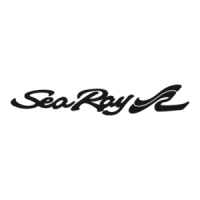
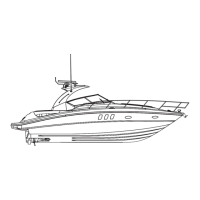
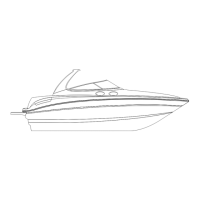
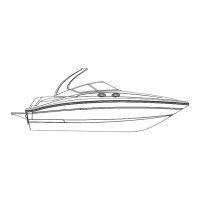
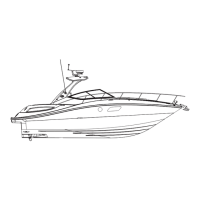
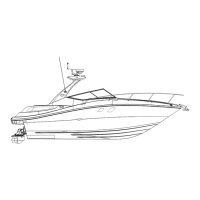

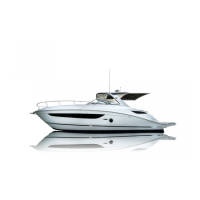
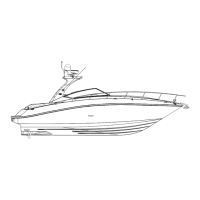

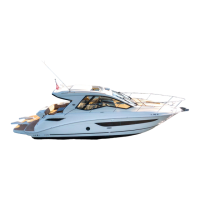
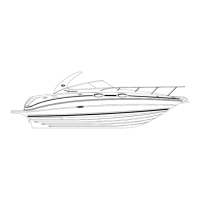
